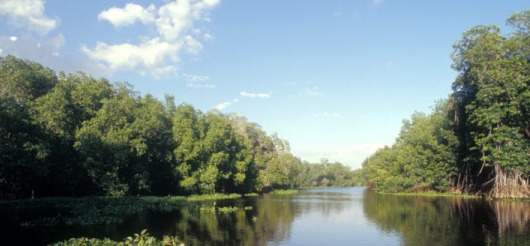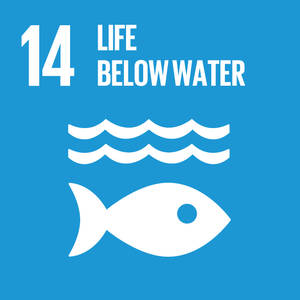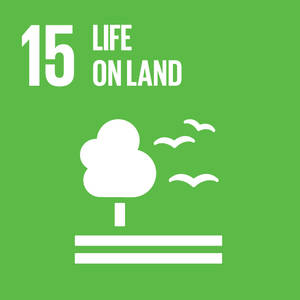Mangroves are salt-tolerant evergreen tree- or shrub-dominated ecosystems that occur in tidally influenced areas along sheltered tropical, subtropical and mild temperate coastlines. In the 123 countries where they occur, mangroves cover an estimated 150 000 km2 (15 million hectares)[1]. Their structure, species composition and ecological characteristics vary widely, as do the ways in which they are used and otherwise valued by humans.
Mangrove ecosystems provide habitat for edible crustaceans and molluscs, nursery and feeding areas for fish and shrimps, and habitats for birds and other wildlife. Fallen leaves and other detritus produced by and washed out of mangrove forests provide a food base for animals such as crabs, clams, oysters, other sorts of shellfish, and bony fish, which, together, feed millions of people.
Mangrove ecosystems vary in the salinity, depth and flow rates of the water that shapes and nourishes them. The substrates on which they develop (and which they, in turn, influence) are also highly variable, ranging from coral rubble to deep silts and clays enriched with abundant organic matter.
[1] Spalding, Kainuma and Collins (2010).
Ecosystem destruction and degradation
Ecosystem destruction and degradation
People have been converting mangrove ecosystems for more than 500 years. Today, mangroves are under pressure nearly everywhere they occur – for example to create shrimp ponds and rice fields and for upland uses such as oil-palm plantations and urban expansion; in certain areas, the latter is now a major threat. Mangroves are considered wasteland in some countries and not part of the national forest estate, which means they are not covered by forestry laws. In other countries, mangroves are under the jurisdiction of forestry departments that focus too much on their wood resources to the detriment of other products and ecosystem services.
Continued high rates of mangrove destruction are only partially counterbalanced by restoration and reforestation efforts. Moreover, global sea-level rise threatens the existence of up to 25 percent of remaining mangrove ecosystems[2]. Normally, mangroves may keep pace with sea-level rises by trapping sediments or migrating inland and upslope. Many mangroves are now imperilled by rising sea levels, however, because river dams and channelization block their sources of sediments, or their landward migration is prevented by steep topography or human infrastructure such as roads and seawalls.
[2] Alongi (2008).
Human uses
Human uses
Humans use mangrove ecosystems for a wide range of purposes. For example, mangroves are the direct sources of food in the form of shellfish, lobsters, crabs and organisms living in the trees and on and under the soil surface. Mangrove trees are harvested for firewood, charcoal and house and dock construction, and as a substrate for oyster settlement. The leaves of some species are used as forage for goats and sheep, while some areas are used for the seasonal grazing of camels and other livestock. Mangrove palms are sometimes tapped for alcohol production, and their leaves are used as a fibre source and to thatch houses. The indirect benefits of mangroves are also diverse – for example, they buffer coastal areas against storm winds and surges, provide spawning grounds for bony fish, and trap sediment. Globally, the total economic value of mangrove prawns, crabs and molluscs alone is estimated at more than US$4 billion per year[3].
[3] Ellison (2008).
Multiple-use management
Multiple-use management
Although the biodiversity values of mangrove ecosystems are well known and the need for holistic approaches to management and restoration is increasingly recognized, many policies on mangrove management continue to emphasize the harvesting of wood for charcoal, as a building material, and for feedstock in the manufacture of rayon. In most cases, however, the combined direct and indirect benefits of intact mangrove ecosystems are far greater than the financial benefits of wood harvesting.
Strides have been made in some areas towards the sustainable management of mangrove forests. Diminishing wood yields after repeated clearcut harvests, however, suggest that more attention needs to be paid to the effects of mangrove wood harvesting on soils and soil organisms.
Carbon
Carbon
The protection, restoration and sustainable management of mangrove ecosystems can help mitigate global climate change. Intact mangrove forests store substantial quantities of carbon in their trees and soils, and regrowing mangroves are capable of rapid rates of carbon fixation.
Coastal bioshields
Coastal bioshields
Mangroves make major contributions to coastal protection from wind, waves and salt spray; this protective function was made evident, for example, by the catastrophic 2004 Indian Ocean tsunami, Typhoon Haiyan in the Pacific, and the storm surges associated with various Atlantic hurricanes. The buffering effect of mangrove forests varies with their width and the heights and densities of the trees, the nearby topography and bathymetry, and the nature of the incident waves.
Restoration challenges
Restoration challenges
Mangrove rehabilitation efforts are often hampered by the improper matching of species with hydrological conditions; propagule predation; poor soil conditions (e.g. acid sulphate soils, which can develop after drainage); weeds; an undue focus on trees at the expense of other organisms; and cost, which can range from a few hundred dollars per hectare to more than one hundred thousand dollars per hectare. The cost needs to be weighed against the many benefits provided by functioning mangrove ecosystems to a wide range of stakeholders, however.






